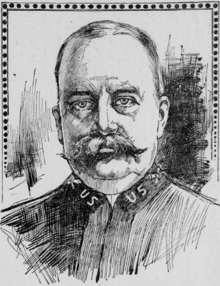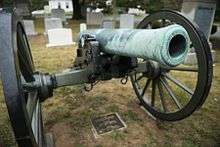Wallace F. Randolph
Wallace Fitz Randolph (June 11, 1841 – December 9, 1910) was a United States Army major general who enlisted as a private at the start of the American Civil War, rose in rank to Major General and, after serving in the artillery branch his entire career, became the first U. S. Army Chief of Artillery.[1][2]
Wallace Fitz Randolph | |
|---|---|
 | |
| Born | June 11, 1841 |
| Died | December 9, 1910 (aged 69) |
| Buried | |
| Allegiance | |
| Service/ | |
| Years of service | 1861–1904 |
| Rank | Major General |
| Battles/wars | American Civil War Spanish–American War |
Early life and career
General Randolph was born in Pennsylvania on June 11, 1841, to Dr. Charles Fitz and Margaret Gooch Randolph. His older brother was Edmund Dutilh Randolph, a prominent New York banker and insurance executive.[3][4][5][6]
Civil War
On April 18, 1861, enlisted as a private in Company F of the 17th Pennsylvania Infantry. He remained in that unit until June 28, 1861 when he was transferred to the newly formed Fifth United States Field Artillery and commissioned as a Second Lieutenant. His cousin Colonel Lorenzo Thomas arranged for his promotion. The unit was formed by proclamation of President Lincoln on May 4, 1861, but not ratified by Congress until mid July. All appointees of the unit, including Randolph, had their ranks dated from May 14, 1861.[1][2][7][8]
His gallantry and display of good judgment in action near Winchester, Virginia, during the Second Battle of Winchester, earned him a brevet to Captain in 1863. It was during this time, Confederate forces captured Lieutenant Randolph's artillery battery and he was wounded. Sent to the infamous Libby prison, a converted brick warehouse in Richmond, Virginia, Randolph worked with others for eight months, standing watch and helping with the digging, eventually escaping the Libby prison. Over the week following, he was able to make his way through the city and into the swamps, avoiding capture until finally making his way to Federal troop positions near Williamsburg, Virginia.[1][2][7][9][10]
He quickly returned to action, and was commended on many occasions for his bravery and efficiency.[2] In 1864, during the Battle of Fair Oaks & Darbytown Road, he was Aide-de-camp for the Fifth U. S. Artillery.[11]
On March 13, 1865, at the close of the war, he was made a brevet Major of Volunteers "for good conduct and meritorious services during the war."[2][7]
1865–1898
After the Civil War, Randolph continued to serve in light artillery units within the 5th Artillery, primarily stationed at Fort Hamilton, New York. In 1876, when his company (Company C) was ordered to Charleston, South Carolina, he moved with it.[12] In 1877, during the labor strikes, he took his battery to various towns in Pennsylvania, West Virginia and Maryland to aid in suppressing violence and protecting property. By November 1881, the 5th Artillery was back in garrison in the forts in New York Harbor, headquartered again at Fort Hamilton.[1][13][14]
Notable amongst ceremonial details in which he participated were funerals for Ulysses S. Grant,[15] and General Winfield Scott Hancock.[16] He also participated in the unveiling of the Statue of Liberty, where his 5th Artillery and Captain Ferdinand P. Earle's National Guard battery exchanged a Feu de joie salute.[17]
In 1888, after promotion to Major, he was assigned to the 3rd Artillery.[18] Initially stationed at Washington Barracks, he served in various billets within the 3rd Artillery's, including Chief Signal Officer,[19] Inspector Artillery Target Practice,[20] and Division Inspector of Artillery.[21]
By 1892, he was artillery sub-post and artillery sub-school commander at Fort Riley, Kansas.[10][22] In 1892, he participated in the dedication ceremony for the World's Columbian Exposition (i.e., the Chicago World's Fair).[23] Almost two years later, he was back in Chicago, commanding a Federal artillery battalion in support of government activities during the labor strike there.[1][13][24]
Following his promotion to Lieutenant Colonel in March 1898, Randolph received orders to go to San Francisco.[25]
Spanish–American War
At the outbreak of the Spanish–American War, Randolph was promoted to Brigadier General, United States Volunteers, and placed in charge of a light artillery brigade at Port Tampa, Florida.[2] He commanded all light artillery units throughout the war and participated in the Battle of Santiago de Cuba.[1]
1899–1904
The Chief of Artillery was created by act February 2, 1901, with Randolph filling that role for first three years. The position would last until 1908, when the Field Artillery and Coast Artillery were made separate.[1]
In 1903, when United States Secretary of War Elihu Root reformed the organization of the War Department and created a joint board, General Randolph was one of the four Army general officers assigned to serve on the board.[26][27]
He retired in January 1904 to his home in Washington, DC.[1]
Promotions
- Second Lieutenant, May 1861
- First Lieutenant, March 1862
- Brevet Captain, June 1863
- Brevet Major, March 1865
- Captain (permanent), July 1866
- Major (permanent), April 1888[2][10][18]
- Lieutenant Colonel, March 1898[28]
- Brigadier General, United States Volunteers, 1899
- Colonel, October 1899
- Chief of Artillery, April 1901[29]
- Brigadier General, February 1903[30]
- Major General, January 1904[1]
Affiliations
He was a member of the Society of the Army of the Potomac.[31]
In 1899, he was elected as a principal officer in the Naval and Military Order of the Spanish–American War, representing the United States Volunteers. He was also made an officer in the Society of the Army of Santiago de Cuba.[32]
After his retirement, he was a member of the Board of Governors at the Chevy Chase Club.[33]
Death and burial

About a year after his retirement, Randolph started showing signs of becoming mentally depressed. Over the years, he grew more despondent, and eventually sought treatment from an alienist. By this time, he was having hallucinations that unknown enemies were pursuing him and his family. On December 9, 1910, he committed suicide in the bathroom of his home on New Hampshire Avenue in Washington, D.C.[1][13]
Honorary pallbearers at his funeral included Brigadier General Montgomery M. Macomb, Colonels Hamilton Rowan (retired) and Charles G. Treat, Majors Parker West (retired), George F. Landers, William Chamberlaine and Henry T. Allen, and Captains Edwin Landon, Johnson Hagood, and Dan Tyler Moore.[13]
His grave marker is one of the most idiosyncratic in Arlington National Cemetery. His resting place, including that of his wife and two daughters, is marked by a twelve-hundred-pound Napoleon cannon.[34] The brass fieldpiece, cast in 1862 and believed to have been used in combat during the American Civil War, was placed shortly after his funeral.[35]
Honors
One of the forts at the Panama Canal's Atlantic terminus was named Fort Randolph in his honor.[36]
Camp Number 27 of the United Spanish War Veterans, in Yonkers, New York, was named for him.[37]
The U.S. Army Mine Planter Major General Wallace F. Randolph. launched in 1942, is named for him.
References
- "General Randolph Ends His Life With Pistol; Ex-Chief of Artillery, U.S.A., Blows Out His Brains in a Fit of Despondency". The New York Times. December 10, 1910. Retrieved 10 June 2015.
- "Lieutenant Colonel W. F. Randolph". The New York Times. May 29, 1898. Retrieved 10 June 2015.
- "Charles Randolph". The Pennocks of Primitive Hall. Rash's Surname Index. Retrieved 12 June 2015.
- Maris, George Lewis; Maris, Annie M. (Pinkerton) (1885). The Maris Family in the United States: A Record of the Descendants of George and Alice Maris. 1683-1885. West Chester, PA: F. S. Hickman. p. 50. Retrieved 12 June 2015.
- "Dr. Edmund D. Randolph, Financier and Insuruance Official, Dies at 81" (PDF). New York Herald. December 21, 1919. Retrieved 12 June 2015.
- Hornor, William S. (1999). This old Monmouth of ours : history, tradition, biography, genealogy, and other anecdotes related to Monmouth County, New Jersey. [Baltimore, Md.]: Clearfield Co. p. 290. ISBN 9780806348605.
- Henry, Guy Vernor (1873). Military Record of Civilian Appointments in the United States Army; volume 2. Carleton. p. 326. Retrieved 10 June 2015.
- Parry Family Records (PDF). Philadelphia: Daniel. C. Ryan. 1877. Retrieved 10 June 2015.
- "Brief Military Services for General Randolph" (The Washington Times). Washington, D. C. December 12, 1910. p. 13. Retrieved 10 June 2015.
- "A Leader of Artillery". The San Francisco Call. San Francisco, CA. April 20, 1898. p. 2. Retrieved 11 June 2015.
- Reports, Documents, and Journals of the U.S. Senate and House of Representatives. Washington DC: Government Printing Office. 1893. p. 1061. Retrieved 10 June 2015.
- "Ordering Forward the Spare Companies". New-York Tribune. New York, NY. October 19, 1876. p. 1. Retrieved 11 June 2015.
- "Military to Pay Honor to Maj. Gen. Randolph". Evening Star. Washington, DC. December 10, 1910. p. 5. Retrieved 10 June 2015.
- Bush, James C. "The Fifth Regiment of Artillery". U.S. Army Center of Military History. Retrieved 11 June 2015.
- "Dust to Dust". Weekly Expositor. Brockway Centre, Michigan. August 13, 1885. p. 2. Retrieved 11 June 2015.
- "Hancock's Funeral". The Somerset Herald. Somerset, PA. February 17, 1886. p. 2. Retrieved 11 June 2015.
- "Liberty Unveiled". The Sun. New York, NY. October 29, 1886. p. 1. Retrieved 11 June 2015.
- "Nominations by the President". Evening Star. Washington, DC. April 30, 1888. p. 1. Retrieved 11 June 2015.
- "The Line". Army and Navy Journal: 121. October 12, 1889. Retrieved 12 June 2015.
- "The Line". Army and Navy Journal: 250. November 28, 1889. Retrieved 12 June 2015.
- "The Army". Army and Navy Journal: 524. March 8, 1890. Retrieved 12 June 2015.
- "Our Light Artillery". The Sun. New York, NY. December 9, 1894. p. 29. Retrieved 11 June 2015.
- "World's Fair". Army and Navy Journal: 106. October 8, 1892. Retrieved 12 June 2015.
- "Scenes at Port Tampa". The New York Times. May 22, 1898. Retrieved 10 June 2015.
- "Army and Navy Orders". Evening Star. Washington, DC. March 15, 1898. p. 1. Retrieved 11 June 2015.
- Root, Elihu (1916). Bacon, Robert; Scott, James Brown (eds.). The Military and Colonial Policy of the United States: Addresses and Reports. Cambridge: Harvard University Press. p. 432. Retrieved 10 June 2015.
- "Army and navy Board; Secretaries Root and Moody Create a Joint Body for the Better Co-operation of the Two Services". The New York Times. July 18, 1903. Retrieved 10 June 2015.
- "Presidential Nominations". The New York Times. March 11, 1898. Retrieved 10 June 2015.
- "The United Service". The New York Times. April 11, 1901. Retrieved 10 June 2015.
- "Congressional Notes". The New York Times. February 20, 1903. Retrieved 10 June 2015.
- The Society of the Army of the Potomac Report of the Thirty-Fifth Annual Re-Union. New York: MacGowan and Slipper. 1904. Retrieved 10 June 2015.
- Greeley, Horace; Cleveland, John Fitch; Ottarson, F. J.; McPherson, Edward; Schem, Alexander Jacob; Rhoades, Henry Eckford (1900). The Tribune Almanac and Political Register. New York: The Tribune Association. p. 181. Retrieved 10 June 2015.
- "A Deadly Social Feud". Omaha Daily Bee. Omaha, Nebraska. April 8, 1907. p. 4. Retrieved 12 June 2015.
- Poole, Robert M. (2010). On hallowed ground : the story of Arlington National Cemetery. New York: Walker & Co. pp. 58–75. ISBN 9780802715494. Retrieved 20 July 2016.
- "With the Rambler". Evening Star. Washington, DC. March 28, 1915. Retrieved 10 June 2015.
- Hoffman, Jon T. (2009). The Panama Canal: An Army's Enterprise. Washington, D.C.: Center of Military History, United States Army. p. 81. ISBN 9780160867279. Retrieved 10 June 2015.
- Simmons, Maurice; Larkin, Ernest W., eds. (1911). Proceedings of the United Spanish War Veterans Department of New York. New York: J. B. Lyon Company, State Printers. Retrieved 10 June 2015.
External links
- "Wallace Fitz Randolph". Arlington National Cemetery. Retrieved 10 June 2015.
- Wallace F. Randolph at Find a Grave
- "Watches Set by a Bugle Call". The New York Times. February 2, 1890. Retrieved 10 June 2015.